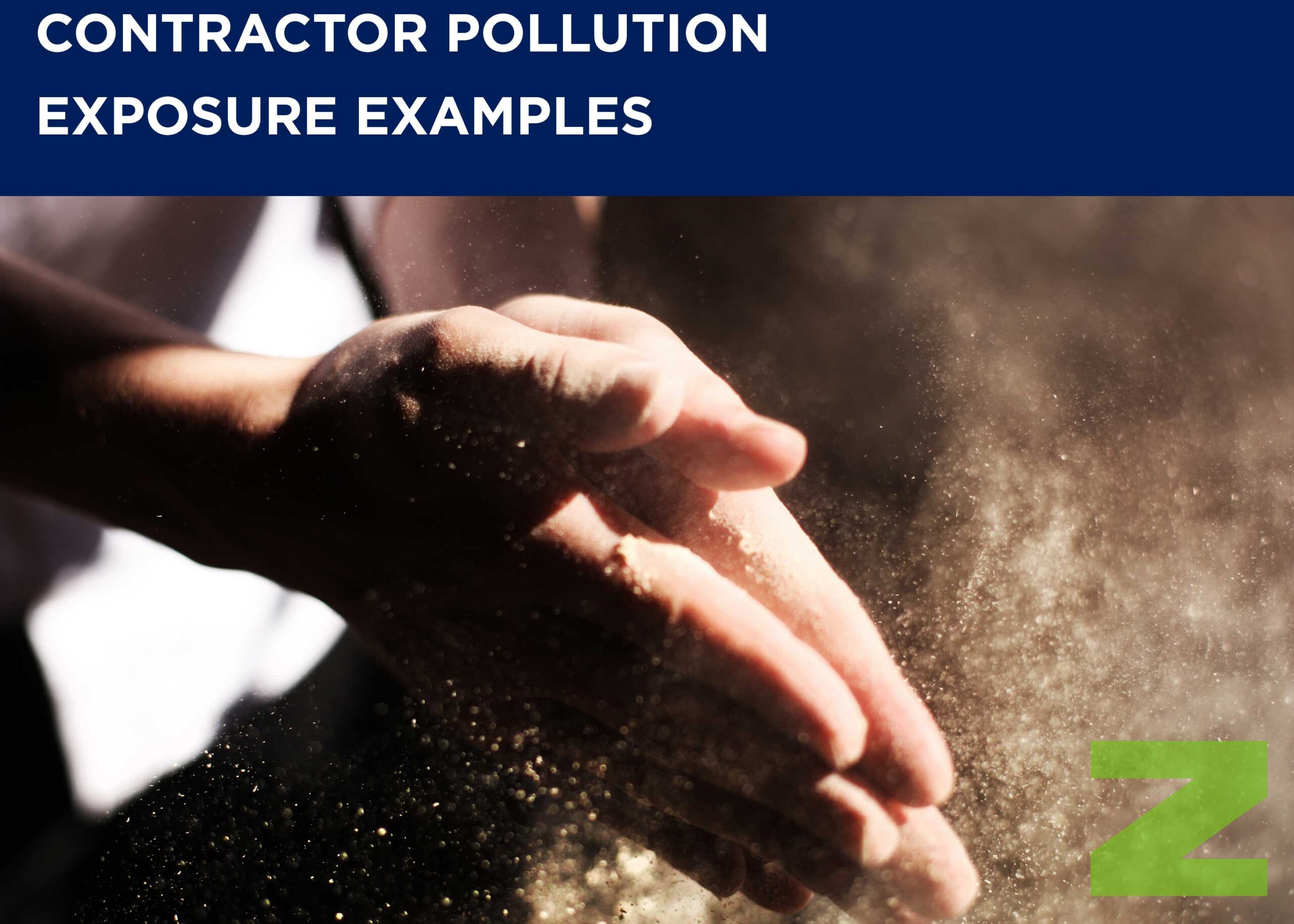CONTRACTOR POLLUTION
EXPOSURE EXAMPLES
Silt/Sedimentation Exposure
A Subcontractor is hired by a General Contractor to
construct a new office building on vacant, undeveloped
land. During the initial clearing/grading phase, the
Subcontractor improperly installs silt fencing. Heavy rain
occurs for a one week period resulting in runoff of silt/
sedimentation to an adjacent property and stream. This
results in a monetary award to the adjacent property owner
for property damage/loss of use and State Agency civil
penalties for silt/ sedimentation run-off into the stream.
Contaminated Soil Exposure
A General Contractor is hired to construct a building in an
urban area. During excavation activities at the construction
site, dump trucks are loaded with dirt to be hauled to a
nearby construction site for fill. The dump truck operators
opted not to utilize their truck tarps during transit because
the receiving facility was roughly three quarters of a mile
from the subject site. The trucks pass by several residential
homes on the way to the receiving facility.
A child is playing in her front yard during these activities and
is subject to inhalation of the dust coming from the dump
trucks. Several days later the child has become severely ill
and is losing her hair. Her parents take her to the hospital and
she is diagnosed with toxic, heavy metal poisoning. The
originating construction site is contaminated with Thallium, a
heavy metal, and the inter-facility release results in monetary
awards for bodily injury and property damage.
Exacerbation Exposure
A Subcontractor is hired by a General Contractor for site
development and grading of a former gas station site to be
redeveloped into a fast food restaurant. During grading
activities, the Subcontractor spreads soil contaminated with
chlorinated solvents from a previously unknown dry cleaner
at the site. The grading activity spreads the once isolated
contaminated soil over the entire site, thereby resulting in
significant costs to remediate the contamination.
Additionally, adjacent property owner files a claim for
business interruption due to the interruption of ingress onto
his property during the associated remediation activities.
Asbestos Exposure
A General Contractor is hired by a commercial building
owner to renovate an existing building in phases. During the
renovation activities, the General Contractor inadvertently
disturbs asbestos covered piping, which releases asbestos
fibers into the ambient air within the building. Tenants of the
building in adjacent areas to the renovation are notified and
asked to evacuate. This results in third-party damages for
business interruption suffered by the commercial tenants,
and allegations of bodily injury resulting from asbestos
inhalation, including associated legal defense expenses.
Mold Exposures
A General Contractor is hired to construct a mixed-use
building. During the construction activities, the General
Contractor improperly installs flashing around certain areas
of the buildings windows and doors. Five months after the
certificate of occupancy is issued for the building, heavy
rains infiltrates into the exterior wall cavity of the building
resulting from the improperly installed flashing, which is
followed by associated mold growth. This results in significant
costs to remediate the building, business interruption, legal
defense expenses, as well as costs for third-party bodily injury
and property damage.
A General Contractor is hired to construct a hotel. The
project is near completion when it was discovered that an
air handler unit needed to be installed on the top floor. The
unit is too large for to fit through the designated opening, so
the General Contractor is required to open a hole in the roof
to allow installation of the air handler. The General
Contractor takes precautions to prevent any rain water from
entering the building during the installation, but a heavy rain
event overwhelms their water prevention controls and the
resulting water damage ends up creating a significant mold
condition in the building. This results in significant costs to
remediate the mold.
Indoor Air Quality/Dust/Silica Exposure
A General Contractor is hired to renovate a structure. During
the construction, concrete is demolished and the General
Contractor appears to have addressed indoor air quality
concerns by identifying intake vents that could possibly be
affected by the work, and those portions of the HVAC
system are turned off. Due to a breakdown in
communication between the General Contractor and
owner/property manager, as well as between the owner/
property manager and other third-party vendors, a third-
party vendor arrives at the site and turns the dormant HVAC
units back on, thereby spreading concrete dust into the
remainder of the building. Concrete dust can contain
harmful amounts of silica. This results in third-party damages
for business interruption, bodily injury and property damage, and also requires an extensive clean-up effort.
Post-Construction Clean-Up Exposure
A General Contractor is hired to renovate a structure around
on-going business operations. The construction is completed
on-time and within budget. During the final walk through, the
General Contractor uses a chemical cleaner to remove
label/tag adhesive from newly installed equipment.
Unfortunately, a building occupant has an adverse reaction
to the chemical cleaner and suffers injury harmful reaction.
This results in legal defense expenses, the need to bring in an
Indoor Air Quality expert to conduct air sampling, and third-
party bodily injury.
Excavation/Grading Contractor Exposure
An excavation/grading contractor is hired to install a new
parking lot and ruptures a historic, unknown/ unmarked
petroleum storage tank causing a release into the
surrounding soil. This results in remediation costs and third-
party business interruption.
Utility Contractor Exposure
A utility contractor is hired to upgrade sewer lines in a
residential neighborhood. Incorrect grading of the new line
results in a sewer line back-up in the basements of the
several homes. This results in third-party property damage,
legal defense expenses associated with multiple claimants,
and third-party bodily injury.





